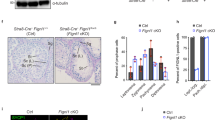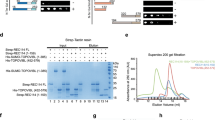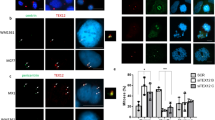Abstract
ATM is a member of the phosphatidylinositol 3-kinase (PIK)like kinases, some of which are active in regulating DNA damage-induced mitotic cell-cycle checkpoints1,2. ATM also plays a role in meiosis. Spermatogenesis in Atm−/− male mice is disrupted, with chromosome fragmentation leading to meiotic arrest3; in human patients with ataxia-telangiectasia (A-T), gonadal atrophy is common. Immuno-localization studies indicate that ATM is associated with sites along the synaptonemal complex (SC), the specialized structure along which meiotic recombination occurs4. Recombination, preceded by pairing of homologous chromosomes, is thought to require heteroduplex formation between homologous DNA, followed by strand exchange. These early meiotic steps (entailing the formation and processing of meiotic recombination intermediates with DNA-strand interruptions) require ssDNA-binding proteins such as replication protein A (RPA; refs 5-7). In somatic cells, DNA damage induces ATM-dependent phosphorylation of RPA8,9. We demonstrate here that ATM and RPA co-localize along synapsed meiotic chromosomes and at sites where interactions between ectopic homologous chromosome regions appear to initiate. In Atm−/− meiotic prophase sper-matocytes, immuno-localization shows that RPA is present along synapsing chromosomes and at sites of fragmentation of the SC. These results suggest that RPA and ATM co-localize at sites where interhomologous-DNA interactions occur during meiotic prophase and where breaks associated with meiotic recombination take place after synapsis, implying a possible functional interaction between these two proteins.
This is a preview of subscription content, access via your institution
Access options
Subscribe to this journal
Receive 12 print issues and online access
$209.00 per year
only $17.42 per issue
Buy this article
- Purchase on Springer Link
- Instant access to full article PDF
Prices may be subject to local taxes which are calculated during checkout
Similar content being viewed by others
References
Savitsky, K. et al. A single ataxia telangiectasia gene with a product similar to Pl-3 kinase. Science 268, 1749–1753 (1995).
Hoekstra, M.F. Responses to DMA damage and regulation of cell cycle checkpoints by the ATM protein kinase family. Curr. Opin. Genet. Dev. 7, 170–175 (1997).
Xu, Y. et al. Targeted disruption of ATM leads to growth retardation, chromosomal fragmentation during meiosis, immune defects, and thymic lymphoma. Genes Dev. 10, 2411–2422 (1996).
Keegan, K.S. et al. The Atr and Atm protein kinases associate with different sites along meiotically pairing chromosomes. Genes Dev. 10, 2423–2437 (1996).
Baumann, P., Benson, F.E. & West, S.C., Rad51 protein promotes ATP-dependent homologous pairing and strand transfer reactions in vitro. Cell 87, 757–766 (1996).
Cox, M.M. & Lehman, I.R. recA protein-promoted DMA strand exchange: stable complexes of recA protein and single-stranded DMA formed in the presence of ATP and single-stranded DNA binding protein. J. Biol. Chem. 257, 8523–8532 (1982).
Flory, J. & Radding, C.M. Visualization of recA protein and its association with DNA: a priming effect of single-stranded binding protein. Cell 28, 747–756 (1982).
Liu, V.F. & Weaver, D.T. The ionizing radiation-induced replication protein A phosphorylation response differs between ataxia telangiectasia and normal human cells. Mol. Cell. Biol. 13, 7222–7231 (1993).
Brush, G.S., Morrow, D.M., Hieter, P. & Kelly, T.J. The ATM homologue MEC1 is required for phosphorylation of replication protein A in yeast. Proc. Natl.Acad. Sci. USA 93, 15075–15080 (1996).
Dobson, M.J., Pearlman, R.E., Karaiskakis, A., Spyropoulous, B. & Moens, P.B. SC proteins, epitope mapping and chromosome disjunction. J. Cell Sci. 107, 2749–2760 (1994).
Ashley, T. et al. Dynamic changes in Rad51 distribution on chromatin during meiosis in male and female vertebrates. Chromosoma 104, 19–28 (1995).
Plug, A.W., Xu, J., Reedy, G., Golub, E.I. & Ashley, T. Presynaptic association of Rad51 protein with selected sites in meiotic chromatin. Proc. Natl. Acad. Sci. USA 93, 5920–5924 (1996).
de Boer, P., Searl, A.G., van der Hoeven, F.A., de Rooij, D.G. & Beechey, C.V. Male pachytene pairing in single and double translocation heterozygotes and spermatogenic impairment in the mouse. Chromosoma 93, 326–336 (1986).
Peters, A.H.F.M., Plug, A.W. & de Boer, P. Meiosis in carriers of heteromorphic bivalents: sex differences and implications for male fertility. Chromosome Res. 5, 313–324 (1997).
Padmore, R., Cao, L.,& Kleckner, N. Temporal comparison of recombination and SC formation during meiosis in S. cerevisiae. Cell 66, 1239–1256 (1991).
Keeney, S., Giroux, C. & Kleckner, N. Meiosis-specific DNA double-strand breaks are catalyzed by Spo1l, a member of a widely conserved protein family. Cell 88, 375–384 (1997).
Sun, H.D., Treco, D., Schultes, N.P. & Szostak, J.W. Double-strand breaks at an initiation site for meiotic gene conversion. Nature 338, 87–90 (1989).
Cao, L., Alani, E. & Kleckner, N. A pathway for generation and processing of double-strand breaks during meiotic recombination in Scerevisiae. Cell 61, 1089–1101 (1990).
Shinohara, A., Ogawa, H. & Ogawa, T. Rad51 protein involved in repair and recombination in S. cerevisiae is a RecA-like protein. Cell 69, 457–470 (1992).
Bishop, D.K., Park, D., Xu, L. & Kleckner, N. DMC1: a meiotic specific yeast homolog of E coli recA required for recombination, SC formation and cell cycle progression. Cell 69, 439–456 (1992).
Hotta, Y., Ito, M. & Stern, H. Synthesis of DNA during meiosis. Proc. Natl. Acad. Sci. USA 56, 1184–1191 (1966).
Hotta, Y. & Stern, H. Analysis of DNA synthesis during meiotic prophase in Lilium. J. Mol. Biol. 55, 337–355 (1971).
Peters, A.H.F.M., Plug, A.W., van Vugt, M.J. & de Boer, P. A drying-down technique for the spreading of mammalian meiocytes from the male and female germ line. Chromosome Res. 5, 66–68 (1997).
Xu, Y. & Baltimore, D. Dual roles of ATM in the cellular response to radiation and in cell growth control. Genes Dev. 10, 2401–2410 (1996).
He, Z., Henricksen, L.A., Wold, M.S. & Ingles, C.J. RPA involvement in the damage-recognition and incision steps of nucleotide excision repair. Nature 374, 566–569 (1995).
Kenny, M.K., Schlegel, U., Furneaux, H. & Hurwitz, J. The role of human single-stranded DNA binding protein and its individual subunits in simian virus 40 DNA replication. J. Biol. Chem. 265, 7693–7700 (1990).
Ried, T., Baldini, A., Rand, T. & Ward, D.C. Simultaneous visualization of seven different DNA probes by in situ hybridization using combinatorial fluorescence and digital imaging microscopy. Proc. Natl. Acad. Sci. USA 89, 1388–1392 (1992).
Moses, M.J. in Animal Models in Human Reproduction (eds Serio, M. & Martini, L) 169–190 (Raven, New York, 1980).
Author information
Authors and Affiliations
Corresponding author
Rights and permissions
About this article
Cite this article
Plug, A., Peters, A., Xu, Y. et al. ATM and RPA in meiotic chromosome synapsis and recombination. Nat Genet 17, 457–461 (1997). https://doi.org/10.1038/ng1297-457
Received:
Accepted:
Issue Date:
DOI: https://doi.org/10.1038/ng1297-457
This article is cited by
-
Lack of sex chromosome specific meiotic silencing in platypus reveals origin of MSCI in therian mammals
BMC Biology (2015)
-
Presence of an extra chromosome alters meiotic double-stranded break repair dynamics and MLH1 foci distribution in human oocytes
Chromosoma (2013)
-
Meiotic homologue alignment and its quality surveillance are controlled by mouse HORMAD1
Nature Cell Biology (2011)
-
DNA polymerase β is critical for mouse meiotic synapsis
The EMBO Journal (2010)
-
Replication protein A (AtRPA1a) is required for class I crossover formation but is dispensable for meiotic DNA break repair
The EMBO Journal (2009)



